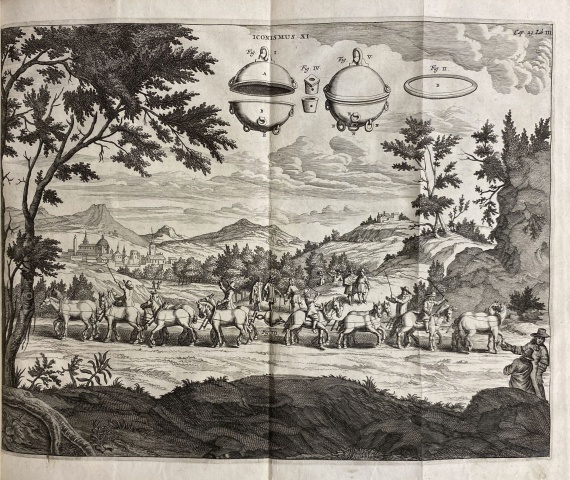Details
GUERICKE, Otto von (1602-1686). Experimenta nova (ut vocantur) Magdeburgica de Vacuo Spatio. Amsterdam: J. Jansson, 1672.
First edition of one of the greatest books in the history of experimental physics. Guericke definitively proved the existence of a vacuum through his famous experiment at Magdeburg, depicted in a double-page engraving in this work which is one of the most reproduced scientific illustrations of all time. The experiment involved two hemispheres of copper fitted together, the air evacuated, and two teams of horses set to pull them apart—which they could not do. To create the vacuum, Guericke invented the air pump, and in the series of experiments that followed he demonstrated the elasticity and weight of air. He also constructed the first electrical generator and demonstrated electrostatic attraction and repulsion. Directly inspired by Copernicanism and its implications for the nature and composition of space, Guericke's groundbreaking work decisively knocked Aristotelian dogma regarding the horror vacui out of orbit. Dibner 55; Evans 30; Horblit 44; Norman 952; Parkinson pp 112-113; Sparrow 90.
Folio (307 x 195mm). Errata leaf at end. Engraved additional title, engraved portrait, and 2 double-page engraved plates, engravings, some full-page, in text (portrait toned, faint marginal dampstaining to a few gatherings). Contemporary Dutch vellum with title in ink on spine. Provenance: a few marginal annotations – signature dated 1874 on front pastedown.
Details
GUERICKE, Otto von (1602-1686). Experimenta nova (ut vocantur) Magdeburgica de Vacuo Spatio. Amsterdam: J. Jansson, 1672.
First edition of one of the greatest books in the history of experimental physics. Guericke definitively proved the existence of a vacuum through his famous experiment at Magdeburg, depicted in a double-page engraving in this work which is one of the most reproduced scientific illustrations of all time. The experiment involved two hemispheres of copper fitted together, the air evacuated, and two teams of horses set to pull them apart—which they could not do. To create the vacuum, Guericke invented the air pump, and in the series of experiments that followed he demonstrated the elasticity and weight of air. He also constructed the first electrical generator and demonstrated electrostatic attraction and repulsion. Directly inspired by Copernicanism and its implications for the nature and composition of space, Guericke's groundbreaking work decisively knocked Aristotelian dogma regarding the horror vacui out of orbit. Dibner 55; Evans 30; Horblit 44; Norman 952; Parkinson pp 112-113; Sparrow 90.
Folio (307 x 195mm). Errata leaf at end. Engraved additional title, engraved portrait, and 2 double-page engraved plates, engravings, some full-page, in text (portrait toned, faint marginal dampstaining to a few gatherings). Contemporary Dutch vellum with title in ink on spine. Provenance: a few marginal annotations – signature dated 1874 on front pastedown.


.jpg)












Testen Sie LotSearch und seine Premium-Features 7 Tage - ohne Kosten!
Lassen Sie sich automatisch über neue Objekte in kommenden Auktionen benachrichtigen.
Suchauftrag anlegen